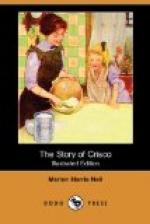2 tablespoonfuls Crisco 1 bunch carrots 1 tablespoonful flour 1/2 teaspoonful sugar 2 tablespoonfuls vinegar Salt and pepper to taste 1 tablespoonful chopped parsley 1 cupful cooked peas
Scrape carrots, cut in small pieces, and boil till tender in boiling salted water. Blend Crisco and flour together in saucepan over fire, stir in 1 cupful water in which carrots were cooked, boil five minutes, then add sugar, seasonings, vinegar, parsley, peas, and carrots; simmer ten minutes and serve hot in vegetable dish.
[Illustration]
SALADS
[Illustration]
Salads are classified into two groups—i.e., the raw, such as lettuce, endive, radishes, cucumber, celery, etc., and the cooked, such as those made from cooked vegetables, eggs, cooked cold fish, poultry, and meat. The raw materials should be washed most carefully and well cleaned before mixing, and the utensils for cutting and mixing, as well as the basins or bowls used, should be clean and dry. Every salad, no matter how plain and simple it may be, should be made to look inviting and tempting. The method of draining or drying is a very easy performance so long as the salad leaves, whatever they may be, are almost free from moisture. This is effected best by putting the leaves, which should be broken, not cut with a knife, into a wire basket and drying them well, or else putting them into a cloth lightly folded and shaking well until the outer moisture of the leaves is well absorbed. The salad then is ready for mixing.
Any cold boiled vegetables left over from dinner are useful as giving variety to salads, and help to make a good accompaniment to cold meat served to luncheon. Thinly sliced cold potatoes—new ones for choice, green peas and string beans, are especially good for this purpose, and even Brussels sprouts, carrots, and turnips may be used on occasion in small quantities. More substantial salads, prepared with cold meat or fish, form appetizing luncheon or breakfast dishes. Those made with chicken, lobster and salmon respectively are most widely known, but fillets of flounder, cold ham or beef, or lamb make very good salads, and even the humble herring, and dried and salted fish, may be used with advantage in this way.
The meat or fish should be cut up into cubes or convenient small pieces, and piled up in the center of the dish or salad bowl on a layer of seasoned, shredded lettuce. Over this should be poured half of the dressing. Round this should be arranged the green constituents of the salad, cut up rather small, garnished with slices of tomato or beets, cucumber and hard-cooked egg. The remainder of the dressing should be poured over this, and the top of the meat or fish pyramid may be ornamented with a few sprigs of endive or parsley.




